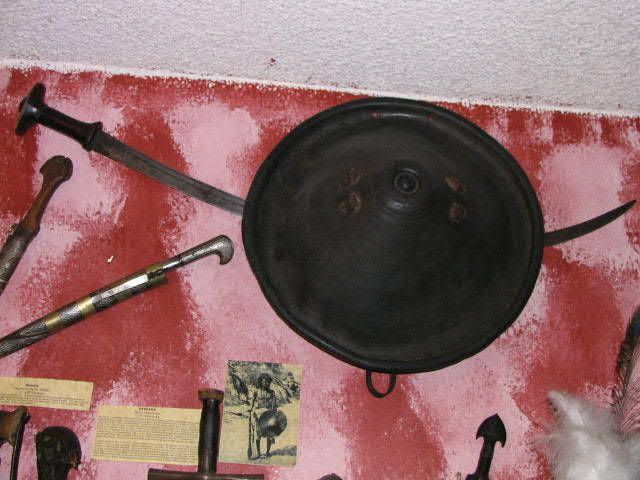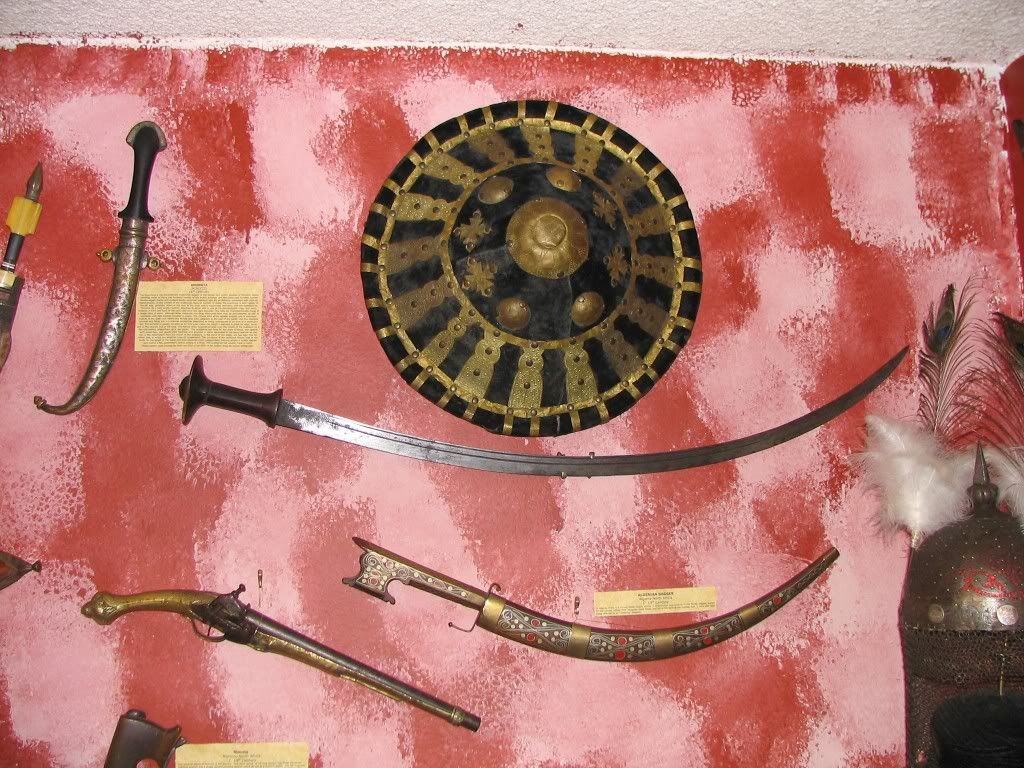
 |
|
|
#1 |
|
Member
Join Date: Jun 2005
Posts: 241
|
Hi guys. As you must know by now, I am interested in Ethiopian weapons. I would like to know how many of you share this interest, even marginally, and how many of you actually have Ethiopian weapons. Hope I'll get some response. Cheers, RON
|
|
|

|
|
|
#2 |
|
Member
Join Date: Dec 2004
Location: Greenville, NC
Posts: 1,854
|
I'm in Ron...even love the food too...but you already knew that.

|
|
|

|
|
|
#3 |
|
Member
Join Date: Dec 2004
Location: Italia
Posts: 1,243
|
Me too, as you know

|
|
|

|
|
|
#4 |
|
(deceased)
Join Date: Dec 2004
Location: East Coast USA
Posts: 3,191
|
Count me in!
Lew |
|
|

|
|
|
#5 |
|
Member
Join Date: Dec 2004
Location: What is still UK
Posts: 5,935
|
How could you not be?

|
|
|

|
|
|
#6 |
|
Member
Join Date: Dec 2004
Location: Ann Arbor, MI
Posts: 5,503
|
I like Gurades, but not food.... Sorry.
Read the most recent Flashman's adventure" Flashman on the March": British Magdala campain. |
|
|

|
|
|
#7 |
|
Member
Join Date: Apr 2005
Location: dc
Posts: 271
|
I like the women moslty but the weapons are nice too.
|
|
|

|
|
|
#8 |
|
Member
Join Date: Jan 2006
Location: Kent
Posts: 2,658
|
Rich history......and some very nice weapons......
|
|
|

|
|
|
#9 |
|
Member
Join Date: Dec 2004
Location: Inland Empire, Southern California USA
Posts: 160
|
Definitely find the weapons interesting. Going to have to try the food.
|
|
|

|
|
|
#10 |
|
Member
Join Date: Dec 2004
Location: B.C. Canada
Posts: 473
|
Count me in Ron! I don't have any in my collection though, someone out here seems to be getting them all first
 . .Jeff |
|
|

|
|
|
#11 |
|
Member
Join Date: Jun 2005
Posts: 241
|
Hi, guys. I'm happy to see some interest. I am sure there still are some guys out there that will join the team. I plan to share with you some of my best pieces (maybe one a week). I would be glad to shatre some food as well .... (Derho Wat is my favourite. SUPER hot!). At least one of you has mentioned the women. They are as fascinating as their swords and as spicy as their food. Cheers, RON
|
|
|

|
|
|
#12 |
|
Member
Join Date: Jun 2005
Posts: 241
|
Here is the first "gem" from my collection. A great Amhara shield of heavy leather, velvet and gilded decorations. I have showed you mine: show me yours!! Selamta. Ron
|
|
|

|
|
|
#13 |
|
Member
Join Date: Dec 2004
Location: Bay Area
Posts: 1,738
|
Marginal interest in the weapons, especially saifs and gurades. Haven't tried the food, and maybe I should.
|
|
|

|
|
|
#14 | |
|
(deceased)
Join Date: Dec 2004
Location: East Coast USA
Posts: 3,191
|
Quote:
roanoa Here is one of mine a sword not a shield though. Lew |
|
|
|

|
|
|
#15 |
|
Member
Join Date: Mar 2005
Location: USA Georgia
Posts: 1,599
|
The the weapons and the religious artifacts are really neat. I have some swords with good german blades. One with a hilt that may be translucent rhino horn. Menelik period.
They even claim to have the Ark of the Covenant somewhere. I really like the prayer scrolls / talismans. Here is an Etiopean curiosity. About 4 inches long. Some kind of silver, probably low grade. Any guesses? If you already know for sure, please hold off posting the answer. I think it would be fun to hear some guesses. |
|
|

|
|
|
#16 |
|
Member
Join Date: Dec 2004
Posts: 1,712
|
Coke spoon if modern or ear cleaner if old?
 Spiral |
|
|

|
|
|
#17 |
|
Member
Join Date: Jun 2005
Posts: 241
|
Hi Bill. SPIRAL nailed it! Post your swords, PLEASE.
|
|
|

|
|
|
#18 | |
|
Member
Join Date: Mar 2005
Location: USA Georgia
Posts: 1,599
|
Quote:
|
|
|
|

|
|
|
#19 |
|
(deceased)
Join Date: Dec 2004
Location: East Coast USA
Posts: 3,191
|
My guess is a snuff spoon I always see the African snuff containers on ebay.
Lew |
|
|

|
|
|
#20 |
|
Member
Join Date: Dec 2004
Location: What is still UK
Posts: 5,935
|
The weapons I have are far from noteworthy but this is. I have not had confirmation that it is Ethiopian but i think it is. I also have a rather nice painting on vellum. I wander off subject. This might be the container for the coke.

|
|
|

|
|
|
#21 | |
|
Member
Join Date: Mar 2005
Location: USA Georgia
Posts: 1,599
|
Quote:
Looks like a one time use lunchbox! |
|
|
|

|
|
|
#22 |
|
Member
Join Date: Mar 2005
Location: USA Georgia
Posts: 1,599
|
I made a mistake in posting. I mant to REPLY and somehow got NEW THREAD. submitted it and then found out that I was wrong, but there seemed no way to put in in your thread. So here is a link.
http://www.vikingsword.com/vb/showthread.php?t=3282 I have more Ethiopian swords and stuff and will post them here in the right thread. |
|
|

|
|
|
#23 |
|
Member
Join Date: Dec 2004
Posts: 1,712
|
Its a coke spoon then Bill?
 I thought an ear wax collector was quite of the wall!  Spiral 
|
|
|

|
|
|
#24 | |
|
Member
Join Date: Mar 2005
Location: USA Georgia
Posts: 1,599
|
Quote:
|
|
|
|

|
|
|
#25 |
|
Member
Join Date: Dec 2004
Posts: 1,712
|
Sorry Bill just teasing,
 You see similar tools in some kukri pouches.  So semi-educated guess realy. So semi-educated guess realy.Spiral |
|
|

|
|
|
#26 |
|
Member
Join Date: Jun 2005
Posts: 241
|
OK, guys. Here is a selection of some European gurade grips and a couple of local imitation. The plain pommel (seen lots of these) has the Lion of Judah and the initial of Menelik on the lanquettes. The "Lion head" (lots of these also) has plain lanquette. The second "lion head" has a more elaborate design and the Lion of Judah on one of the lanquettes, the other one is plain. (Only seen two of these). The fourth one (unique) was copied/imitated in German silver by a local smith. Both lanquettes have the Lion of Judah. Last (also unique) is a gilded, locally made high quality one. Blade is a very nice Wilkinson. Both lanquettes have angels. Can any of you add to this?
|
|
|

|
|
|
#27 |
|
Member
Join Date: Dec 2004
Location: Inland Empire, Southern California USA
Posts: 160
|
Didn't have a chance to show the examples I have of Ethiopian weapons in my earlier post. At least I'm pretty sure the shields are right.
 
|
|
|

|
|
|
#28 |
|
Member
Join Date: Jun 2005
Posts: 241
|
I can see your interest spans from Morocco to Somalia.... Nice gurade and shuields. Even nicer billao.
|
|
|

|
|
|
#29 |
|
Member
Join Date: Mar 2005
Location: USA Georgia
Posts: 1,599
|
I saw Ron's posting of the Guades and though I might post this one.
Did a little blade cleanup with 600 grit and 1500 grit sandpaper. Sure would like to have a translation. I am sure that I will post these upside down. Have no ida about which way is corrrect, but everytime I ask for a translation, its upside down. Does the GG and thermometer on the blade mean some sword manufacturer like Solingen? Anyway here it is. |
|
|

|
|
|
#30 |
|
Member
Join Date: Jun 2005
Posts: 241
|
The first word on the blade is MENELIK (Emperor of Ethiopia before Haile Selassie) and you have it upside down. Ethiopian sentences (in this case it's just a word) end with 4 dots as in the second inscription which is SAINT GEORGE (protector of Ethiopia). The writing on the ricasso is a bit of a puzzle because it says NIKOLA SUPPLIER TO THE EMPEROR and I have no idea of who this NIKOLA was. Maybe one of the many Armenian traders that supplied European goods to Ethiopia. The GG has generated a flurry of interpretations. Someone has suggested GRENAL of GLASGOW (doubt it...) or GEBRUDER GRAH (doubt it...). Jeff Demetrick and I had a discussion about this and we agree that in all likelyhood is GESETZLICH GESCHUETZT (ofter referred to as GES GESH) which I believe means REGISTERD MARK. I actually documented a sword that under the Lion of Judah has the words GES GESH. Jeff also identified the thermometer, but I have to dig out that info. Jeff: help!!
|
|
|

|
 |
|
|